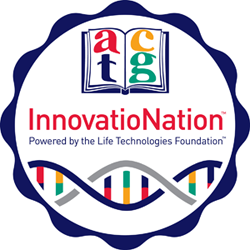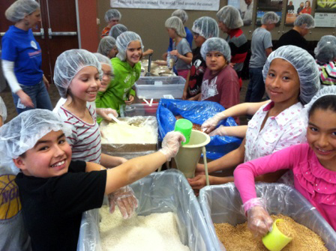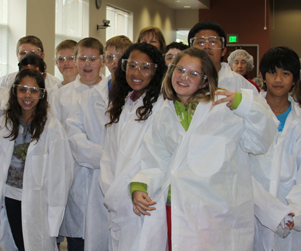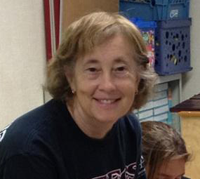InnovatioNation: Bringing Biotechnology to Local Classrooms
Life Technologies' InnovatioNation helps introduce students to biotechnology and to the role of science in addressing global concerns. Teachers participating in InnovatioNation use Science Buddies to help support the science curriculum and their school science fair.

When North Broadway School received their state test scores from last spring, the impact of the increased science curriculum was dramatic. The school's science score showed tremendous improvement, increasing from 65% to 86%. "Our principal is ecstatic," says Judith. "We are the stars of the school. Life Technologies foundation made a big difference!"
To support teachers who are taking part in InnovatioNation, Science Buddies has created a dedicated resource with suggested projects that fit the InnovatioNation modules for 5th, 7th, and 9th grade classrooms.
Despite their efforts to boost science literacy, Judith says she and the other teachers were "overwhelmed" when they realized that one of the requirements for taking part in Life Technology's InnovatioNation program is to hold either a family science night or a school science fair. The program, designed for fifth, seventh, and ninth grade teachers and classrooms, supports teachers looking to enhance their STEM curriculum by introducing students to the world of biotechnology and exposing students to areas of life sciences, including genetics, agricultural engineering, and regenerative medicine. In addition, InnovatioNation helps students better understand what it is like to "be" a scientist, highlights the importance of philanthropy through service, and shows students how science can be used to address both global and community challenges. Through InnovatioNation, Life Technologies encourages employees to volunteer in their communities and to make connections with the students who will become the scientists of tomorrow.
Invited to participate in the InnovatioNation pilot program, Judith and the teachers at North Broadway School were excited by the prospect of InnovatioNation. The science fair requirement was a concern, but Life Technologies assured them that schools like North Broadway can successfully organize a science fair and guide students in preparing science fair projects. Up to the challenge, Judith spearheaded the school's participation in the program.
On Board with InnovatioNation
The InnovatioNation program is designed to intersect with a teacher's regular curriculum during a twelve-week period. In the semester before the InnovatioNation pilot began, Judith met with Life Technologies to fine tune North Broadway's fifth-grade science curriculum in preparation for the science that would be covered as part of InnovatioNation. To help support Judith in the integration of the fifth-grade InnovatioNation science module, the program provided a full set of classroom materials. "I received a full binder complete with timelines, pre- and post-tests, lessons, and information about Science Buddies," says Judith.
Judith's class studied cells and cellular function during the Fall semester as part of their regular science curriculum. They were then ready to tackle introductory genetics in the Spring, when Judith taught two InnovatioNation-provided genetics lessons involving Punnett squares, a diagram that helps visually represent principles of Mendelian inheritance. This was entirely new material for Judith's students, and material that would not ordinarily have made its way into her classroom. But her students responded eagerly.
"My students were fascinated by the idea of constructing an individual but became predictably riotous when I asked if anyone wanted to volunteer as 'Mom' and 'Dad' to determine the eye and hair color of their offspring." Familiar with this typical elementary-school response to "boy/girl" issues, Judith wasn't fazed. Drawing from a jar of "name sticks" she uses as part of her classroom environment, she randomly paired up the students so they could track through the genetics. The activity was a success. "They loved it," says Judith.
Judith's class then took a sponsored field trip to Life Technologies. Due to budget limitations, this was her class's only field trip of the year, so there was plenty of excitement as the students boarded busses for their on-site tour of Life Technologies in Carlsbad, CA. During the three-hour tour, Judith's students wore lab coats given to them as part of the field trip and rotated between three different stations created to highlight science careers, community service, and what a science company and lab really looks like. "The fact that not one in ninety students ever asked to use the bathroom or said they were hungry during that time speaks highly of their level of engagement," says Judith. "I can't tell you enough how unusual that is."
One of the stations Judith's students visited at Life Technologies engaged them in a community service project where they helped package high-protein meals. "They worked in an assembly line, and teams of ten raced each other," says Judith. "They managed to package over 7,000 meals." Beyond the satisfaction and reward of helping with a large-scale community service project, Judith says she and her colleagues thought the assembly-line experience "would convince them of the value of higher education." Instead, the food packaging project "was their favorite activity," she notes, "which reminded us of how ten-year olds still prefer 'doing' to 'listening.'"


Students visited Life Technologies where they helped with a community service project
and got a chance to experience a real lab environment.
Despite the fun they had racing each other to package foods, Judith says the students were enthusiastic about the other stations, one of which involved a tour of the Life Technologies labs and one which gave them a chance to interview scientists to find out more about their day-to-day work and what it really "means" to be a scientist. After the field trip, Judith and the other teachers had their students write about the experience, about the stations they visited, and about what they learned. From their comments, Judith says it was clear that the field trip was eye opening and meaningful. "Their writing revealed many ways in which their understanding of a scientist's daily life was altered," by what they saw and learned at Life Technologies, and what struck them was wide-ranging, says Judith. Things that stood out for her students included "the fact that employees walked on treadmills during meetings, the fact that every item in a lab station was outlined in blue tape, the fact that everything had to be kept clean to the point of having sticky mats at the doorways, and the way in which bacteria is 'grown.'"
After the field trip, Life Technologies volunteers came to the school and presented a one-hour lesson to each class focused on the problem of producing enough food in certain parts of the world to feed the local population. After a presentation on the problem, the students were divided up for a hands-on activity that both encouraged global thinking and social consciousness and also highlighted the role of biotechnology in helping address problems like world hunger. Each small group was "given the life story of a child with a description of his/her particular town or village somewhere in the world where the people are struggling to find a way to grow crops in their particular climate and habitat," explains Judith.
Using materials brought in by Life Technologies, "the students [studied] the growing requirements of various food crops to determine which traits would be a good match for the given habitat." After identifying the kinds of crops and traits that might succeed in the environment, they used "cloning scissors" to make a paper-based "clone" of a genetically engineered crop suited to the environment. The final component of the lesson involved having the students count bacteria on live trays so they could observe the results of cloning, a hands-on experience that offered a concrete look at the kind of biotechnology they had been talking about and hypothesizing using their paper-based crop models.
The Value of a Science Fair
The final activity related to InnovatioNation was the school science fair, the first for Judith's school, and the source of Judith's initial concern about taking part in InnovatioNation. "Our students did not yet understand how to formulate a testable question or how to conduct a controlled experiment," explains Judith. "But we knew that these skills were critical to understanding what it is to be a scientist, so we carved out the time to guide them through the process."

Part of the solution for teachers at North Broadway, involved their students spending time in another lab—the computer lab—and using resources available at Science Buddies. "My students used the Topic Selection Wizard and truly enjoyed looking for an experiment and printing it out," says Judith. As her students learned more about the scientific process, Judith handed out copies of key resource pages from the Science Buddies Project Guide, like how to construct a hypothesis statement, to help as they moved through the steps of the scientific method.
The science fair was held in conjunction with the school's end-of-year Open House. Volunteers from Life Technologies were on hand to judge the entries from the three fifth grade classes, using Science Buddies' Project Judging Scorecard for Elementary School. (See other project scoring and grading rubrics.) Judith says the students were very excited about presenting their projects at the fair and "wore their lab coats from the Life Technologies field trip all day long." Following review and judging of all projects, three awards and a "special award" were presented in each class. "The students who emerged as winners, with the clearest explanation of the science behind their experiment, were not those you might have predicted," says Judith. "Their awards were possibly the highlight of their entire school year."
Looking Forward
For both the students and the teachers, the science fair was a success, and teachers at North Broadway plan to hold a science fair again next year, making it part of a school-wide Family Science Night. "I believe that hands-on science is the only way to teach in fifth grade, and I believe that it needs to be elevated to a position of importance in the eyes of both students and parents," says Judith. "A science fair does just that."
Judith's experience with InnovatioNation and her school's first science fair has given her concrete ideas for ways they will modify their approach next year. For example, she says they may focus next year's fair on Life Sciences projects to better complement their work with InnovatioNation. They also hope to modify their Friday science lab time so that it follows the process students will use in their own projects. "We are going to ask our lab instructor to begin all of her labs with a form of testable question or hypothesis and close the lab with a conclusion. This way they will be better prepared for their own experiments," explains Judith.
Judith and North Broadway School will again be participating in InnovatioNation this coming year. "I am truly excited that our school has been chosen to work for a second year with Life Technologies and Science Buddies!"
Science Buddies Project Ideas in Genetics and Genomics are sponsored by support from Life Technologies Foundation.
Categories:
You Might Also Enjoy These Related Posts:
- Making Recycling Sorting Machines—STEM Success
- Mini Trebuchets and a NM MESA Challenge
- Helping Students Build Coding Skills with Drones and Self-Driving Cars
- Middle School Student Codes to Improve Life with Visual Impairment
- Student Science Project - Designing and Coding a Video Game to Help People with Alzheimer's
- Teacher Combines Computer Science and Engineering Design for Middle School Students - STEM Success Story
- A Mirror Maze Success Story
- Paper Roller Coasters and Energy Transformation: STEM Teacher Success Story










